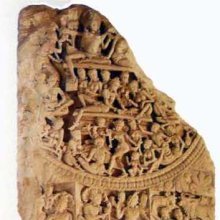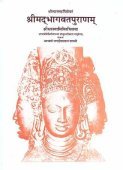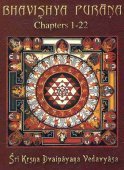Nanda, Nandā, Namda: 47 definitions
Introduction:
Nanda means something in Buddhism, Pali, Hinduism, Sanskrit, Jainism, Prakrit, the history of ancient India, Marathi, biology. If you want to know the exact meaning, history, etymology or English translation of this term then check out the descriptions on this page. Add your comment or reference to a book if you want to contribute to this summary article.
Images (photo gallery)
In Hinduism
Vastushastra (architecture)
Source: Wisdom Library: Vāstu-śāstraNanda (नन्द) refers to a type of temple (prāsāda) classified under the group named Lalita, according to Samarāṅgaṇasūtradhāra chapter 56. The Lalita group contains twenty-five out of a sixty-four total prāsādas (temples) classified under four groups in this chapter. The Samarāṅgaṇasūtradhāra is an 11th-century encyclopedia dealing with various topics from the Vāstuśāstra.
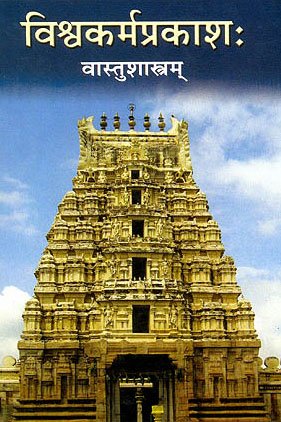
Vastushastra (वास्तुशास्त्र, vāstuśāstra) refers to the ancient Indian science (shastra) of architecture (vastu), dealing with topics such architecture, sculpture, town-building, fort building and various other constructions. Vastu also deals with the philosophy of the architectural relation with the cosmic universe.
Natyashastra (theatrics and dramaturgy)
Source: Wisdom Library: Nāṭya-śāstraNandā (नन्दा) is the name of an Apsara created for the sake of a type of dramatic perfomance. Acording to the Nāṭyaśāstra 1.46-51, after Brahmā asked Bharata for materials necessary for the Graceful Style (kaiśikī: a type of performance, or prayoga), Bharata answered “This Style cannot be practised properly by men except with the help of women”. Therefore, Brahmā created with his mind several apsaras (celestial nymphs), such as Nandā, who were skillful in embellishing the drama.

Natyashastra (नाट्यशास्त्र, nāṭyaśāstra) refers to both the ancient Indian tradition (shastra) of performing arts, (natya—theatrics, drama, dance, music), as well as the name of a Sanskrit work dealing with these subjects. It also teaches the rules for composing Dramatic plays (nataka), construction and performance of Theater, and Poetic works (kavya).
Purana and Itihasa (epic history)
Source: Wisdom Library: Varāha-purāṇa1) Nanda (नन्द).—One of the sons of Medhātithi, who was a son of Priyavrata, according to the Varāhapurāṇa chapter 74.
2) Nandā (नन्दा).—One of the seven major rivers in Śākadvīpa, according to the Varāhapurāṇa chapter 86. Śākadvīpa is one of the seven islands (dvīpa), ruled over by Medhātithi, one of the ten sons of Priyavrata.
Priyavrata was a son of Svāyambhuva Manu, who was created by Brahmā, who was in turn created by Nārāyaṇa, the unknowable all-pervasive primordial being.
The Varāhapurāṇa is categorised as a Mahāpurāṇa, and was originally composed of 24,000 metrical verses, possibly originating from before the 10th century. It is composed of two parts and Sūta is the main narrator.
Source: archive.org: Puranic Encyclopedia1) Nanda (नन्द).—(nandaka) See under Nandagopa.
2) Nanda (नन्द).—(See under Vararuci).
3) Nanda (नन्द).—A son of Dhṛtarāṣṭra. In the battle of Kurukṣetra, Bhīmasena killed him. (Mahābhārata Karṇa Parva, Chapter 51, Stanza 19).
4) Nanda (नन्द).—A serpent born in the family of Kaśyapa (Mahābhārata, Udyoga Parva, Chapter 103, Stanza 12).
5) Nanda (नन्द).—A warrior of Subrahmaṇya. (Mahābhārata Śalya Parva, Chapter 45, Stanza 64).
6) Nanda (नन्द).—A synonym of Bhagavān Viṣṇu. (Mahābhārata Anuśāsana Parva, Chapter 149, Stanza 69).
7) Nandā (नन्दा).—Wife of Harṣa the third son of Dharmadeva. (Mahābhārata Ādi Parva, Chapter 66, Stanza 33).
8) Nandā (नन्दा).—A river. Mention is made in Mahābhārata, Ādi Parva, Chapter 214, Stanza 6, that while Arjuna had been engaged in a pilgrimage visiting the holy places in the east, he reached the banks of the rivers Nandā and Aparanandā. Many of the scholars are of opinion that this river flowed through the eastern side of the forest Naimiṣaraṇya. When the hermit Dhaumya talks about the holy places of the east to Yudhiṣṭhira, he says as follows about the river Nandā. "The beautiful mountain 'Kuṇḍoda' is a place which abounds in roots, fruits and water. Nala the King of Niṣadha, who was weary of thirst rested here. There is a holy temple here called Devavana which is thronged by hermits. Near this temple there is a mountain through the top of which, two rivers Bāhudā and Nandā flow." (Mahābhārata Vana Parva, Chapter 87).
During the time of the forest life of the Pāṇḍavas, Yudhiṣṭhira travelled with the hermit Lomaśa, through the basin of the rivers Nandā, and Aparanandā. During the Paurāṇic times some deities had lived in the basin of the river Nandā, and men began to come there to visit the deities. The devas (gods) did not like this and so they rendered the place inaccessible to men. From that time onwards the river basin of Nandā and the mount Hemakūṭa have become prohibited area for human beings. (Mahābhārata Vana Parva, Chapter 110).
Source: archive.org: Shiva Purana - English TranslationNandā (नन्दा) is the name of a river situated near Saugandhika, according to the Śivapurāṇa 2.2.40.—Accordingly, as Brahmā narrated to Nārada:—“[...] Near [Kailāsa], the gods saw Alakā, the beautiful and divine city of Kubera. [...] Near that they saw the sylvan park Saugandhika [...]. Outskirting it are the two holy rivers Nandā and Alakanandā that quelled sins by their mere sight. The celestial damsels descending to them from their world drank their waters. Emaciated for their sexual dalliance with their menfolk they entered them for their sports”.
Note: Nandā, Alakanandā and Bhāgīrathī are three famous branches of Gaṅgā in the upper course in the Pauri-Garhwal region.
Source: Cologne Digital Sanskrit Dictionaries: The Purana Index1a) Nanda (नन्द).—An attendant on Puruṣottama Viṣṇu (Hari);1 praised Dhruva;2 went with Hari going to Pṛthu's sacrifice;3 attacked the Asuras, the followers of Bali.4
- 1) Bhāgavata-purāṇa II. 9. 14; X. 39. 53; 89. 57; VIII. 22. 15.
- 2) Ib. IV. 12. 22.
- 3) Ib. IV. 19. 5; VI. 4. 39.
- 4) Ib. VIII. 21. 16.
1b) A mountain of Krauñcadvīpa.*
- * Bhāgavata-purāṇa V. 20. 21.
1c) A son of Madirā and Vasudeva.*
- * Bhāgavata-purāṇa IX. 24. 48; Brahmāṇḍa-purāṇa III. 71. 171; Vāyu-purāṇa 96. 169; Viṣṇu-purāṇa IV. 15. 23.
1d) A king of the Nanda dynasty;1 from Parīkṣit to Nanda the period was 1115 years; At the time of Nanda the Saptaṛṣis moved from Magha to Pūrvāṣāḍha.2
1e) The fourth son of Medhātithi and founder of the Nanda Kingdom.*
- * Brahmāṇḍa-purāṇa II. 14. 36-9.
1f) A Vānara chief.*
- * Brahmāṇḍa-purāṇa III. 7. 234.
1g) A son of Śūra and Bhojā.*
- * Matsya-purāṇa 46. 3.
1h) City; Uragapati, in the third Tala or Vitalam.*
- * Vāyu-purāṇa 50. 29.
1i) An Ajitadeva.*
- * Vāyu-purāṇa 67. 34.
1j) The Royal dynasty preceding the Mauryas;1 commence their line when the Seven Ṛṣis reach Pūrvāṣāḍha, and after 1065 years from Parīkṣit.2
2a) Nandā (नन्दा).—A celestial R. of Śālmalidvīpa, and sacred to Hari;1 sacred to Pitṛs.2
2b) North of Vedi, sacred to Mahādeva.*
- * Brahmāṇḍa-purāṇa III. 13. 82-3.
2c) A Śakti; a goddess enshrined at the Himālayan slopes.*
- * Brahmāṇḍa-purāṇa IV. 44. 72; Matsya-purāṇa 13. 30.
2d) A R. of Śākadvīpa: Pārvatī.*
- * Matsya-purāṇa 122. 31; Vāyu-purāṇa 49. 92.
2e) A river in Kailāsa.*
- * Vāyu-purāṇa 41. 18.
Nanda (नन्द) is a name mentioned in the Mahābhārata (cf. IX.44.59, V.101.12/V.103, VI.47.8, IX.44.59, IX.44.60) and represents one of the many proper names used for people and places. Note: The Mahābhārata (mentioning Nanda) is a Sanskrit epic poem consisting of 100,000 ślokas (metrical verses) and is over 2000 years old.
Nandā also refers to the name of a River or Tīrtha (pilgrim’s destination) mentioned in the Mahābhārata (cf. II.82.138, III.85.21).

The Purana (पुराण, purāṇas) refers to Sanskrit literature preserving ancient India’s vast cultural history, including historical legends, religious ceremonies, various arts and sciences. The eighteen mahapuranas total over 400,000 shlokas (metrical couplets) and date to at least several centuries BCE.
Shaivism (Shaiva philosophy)
Source: Wisdom Library: ŚaivismNandā (नन्दा) is a Sanskrit name of one of the five cow-mothers, born from the churning of the milk ocean and descended on earth from Śiva’s world at the latter’s behest for the welfare of the people, according to the Śivadharmottarapurāṇa

Shaiva (शैव, śaiva) or Shaivism (śaivism) represents a tradition of Hinduism worshiping Shiva as the supreme being. Closely related to Shaktism, Shaiva literature includes a range of scriptures, including Tantras, while the root of this tradition may be traced back to the ancient Vedas.
Kavya (poetry)
Source: Wisdom Library: KathāsaritsāgaraNanda (नन्द) is the name of a King, whose captial city was called Pāṭaliputra, according to the Kathāsaritsāgara chapter 2. In this city lived two brothers, named Varṣa, and Upavarṣa whose story was told in the aforementioned book.
The Kathāsaritsāgara (‘ocean of streams of story’), mentioning Nanda, is a famous Sanskrit epic story revolving around prince Naravāhanadatta and his quest to become the emperor of the vidyādharas (celestial beings). The work is said to have been an adaptation of Guṇāḍhya’s Bṛhatkathā consisting of 100,000 verses, which in turn is part of a larger work containing 700,000 verses.
Source: OpenEdition books: Vividhatīrthakalpaḥ (Kāvya)1) Nanda (नन्द) is the name of a boatman, as mentioned in the Vividhatīrthakalpa by Jinaprabhasūri (13th century A.D.): an ancient text devoted to various Jaina holy places (tīrthas).—Accordingly, “An irreducible hatred opposes the boatman Nanda in his various existences and the monk Dharmaruci, who, in the face of his embezzlement, consumes him thanks to his powers. Having become king, Nanda poses a riddle and offers half of his kingdom to whomever will solve it. It is read to the religious who confuses his enemy by answering it. The king becomes a pious Jaina. The religious is delivered”.
Cf. Āvaśyakacūrṇi I 516.5-517.8; Āvasyakaniryukti (Haribhadra commentary) a.9-a.6; Trad : Leumann WZKM 5 1891, p. 142-144; The legend of Dharmaruci is part of the Namaskāravyākhyā of 1'Āvaśyakacūrṇi: for an analysis of the whole, cf. Mette IT 1983 p. 129-144; Balbir 1986 p. 661.
2) Nanda (नन्द) is the name of an ancient king, according to the same Vividhatīrthakalpa.—Accordingly, “A series of wonders brought Nanda to the throne despite her obscure birth. He first dreamed that the city was surrounded by its bowels. The Master to whom he confided, understood the meaning and intended his daughter for him. On the day of the ceremony, Nanda's wedding procession met that of ministers who carried the royal insignia on the death of King Udāyin, due to the fact that he had no children. The elephant took Nanda on his back, the horses bowed, etc. He was named king”.
Cf. Āvaśyakacūrṇi II 180.4-8; Āvasyakaniryukti (Haribhadra commentary) b.3-8; Leumann 1934 p. 24; Paris.VI. v. 231-243: Jacobi analysis1932 p. LXII-LXIII.

Kavya (काव्य, kavya) refers to Sanskrit poetry, a popular ancient Indian tradition of literature. There have been many Sanskrit poets over the ages, hailing from ancient India and beyond. This topic includes mahakavya, or ‘epic poetry’ and natya, or ‘dramatic poetry’.
Jyotisha (astronomy and astrology)
Source: academia.edu: Tithikarmaguṇa in GārgīyajyotiṣaNandā (नन्दा) or Nandatithi is the name of the first of fifteen tithis (cycle of time) according to both the Gārgīyajyotiṣa and the Śārdūlakarṇāvadāna. The associated deity for Nandā according to the Bṛhatsaṃhitā is Brahma. A tithi was defined as one thirtieth of a synodic month (c. 29.5 days), resulting in an average tithi being slightly less than a day.
Accordingly, “(11) The first tithi is said to be Nandā. It is auspicious for firm acts, for the commencement of learning; traveling on a journey is however forbidden. (12) One should give gifts, perform asceticism. Birth on this tithi is the best, characterized by prosperity and fortune. Its deity is Svayambhū”.

Jyotisha (ज्योतिष, jyotiṣa or jyotish) refers to ‘astronomy’ or “Vedic astrology” and represents the fifth of the six Vedangas (additional sciences to be studied along with the Vedas). Jyotisha concerns itself with the study and prediction of the movements of celestial bodies, in order to calculate the auspicious time for rituals and ceremonies.
Chandas (prosody, study of Sanskrit metres)
Source: Journal of the University of Bombay Volume V: Apabhramsa metres (2)1) Nandā (नन्दा) is the name of a antarasama-catuṣpadi metre (also known as Ardhasama), as discussed in books such as the Chandonuśāsana, Kavidarpaṇa, Vṛttajātisamuccaya and Svayambhūchandas.—Nandā is made up of 13 (4, 5, [IS]) and 15 (4, 4, [ISI], [IS]) mātrās in their odd and even lines respectively.
2) Nandā (नन्दा) also refers to a variety of Raḍḍā or Mātrā: the only metre consisting of five lines.—Mātrā seems to be a very old Apabhraṃśa metre since it was known to Virahāṅka (see Vṛttajātisamuccaya). Piṅgala discusses [the Mātrā metre] under Raḍḍā, and gives seven varieties of it [viz., Nandā, consisting of the following mātrās: 14,11,14,11,14].
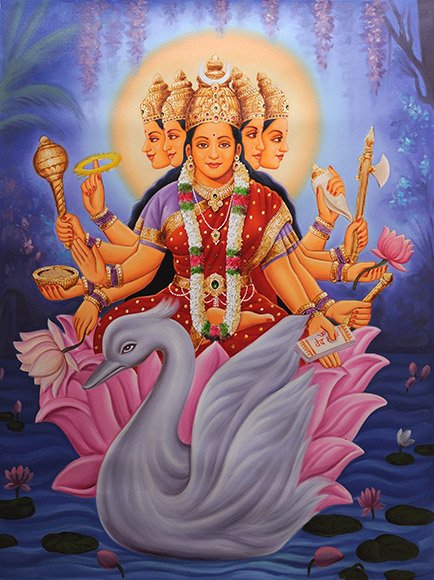
Chandas (छन्दस्) refers to Sanskrit prosody and represents one of the six Vedangas (auxiliary disciplines belonging to the study of the Vedas). The science of prosody (chandas-shastra) focusses on the study of the poetic meters such as the commonly known twenty-six metres mentioned by Pingalas.
Shaktism (Shakta philosophy)
Source: Google Books: ManthanabhairavatantramNandā (नन्दा) refers to one of the eight Yoginīs (yoginyaṣṭaka) associated with Oṃkārapīṭha (also called Oḍḍiyāna, Ādipīṭha or Uḍapīṭha), according to the Manthānabhairavatantra, a vast sprawling work that belongs to a corpus of Tantric texts concerned with the worship of the goddess Kubjikā.—[...] The eight Yoginīs (yoginyaṣṭaka): Jayā, Vijayā, Jayantī, Aparājitā, Nandā, Bhadrā, Bhīmā and Śrīdevī

Shakta (शाक्त, śākta) or Shaktism (śāktism) represents a tradition of Hinduism where the Goddess (Devi) is revered and worshipped. Shakta literature includes a range of scriptures, including various Agamas and Tantras, although its roots may be traced back to the Vedas.
Ganitashastra (Mathematics and Algebra)
Source: archive.org: Hindu MathematicsNanda (नन्द) represents the number 9 (nine) in the “word-numeral system” (bhūtasaṃkhyā), which was used in Sanskrit texts dealing with astronomy, mathematics, metrics, as well as in the dates of inscriptions and manuscripts in ancient Indian literature.—A system of expressing numbers by means of words arranged as in the place-value notation was developed and perfected in India in the early centuries of the Christian era. In this system the numerals [e.g., 9—nanda] are expressed by names of things, beings or concepts, which, naturally or in accordance with the teaching of the Śāstras, connote numbers.
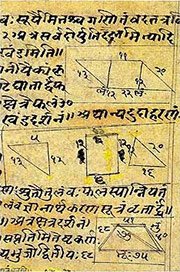
Ganitashastra (शिल्पशास्त्र, gaṇitaśāstra) refers to the ancient Indian science of mathematics, algebra, number theory, arithmetic, etc. Closely allied with astronomy, both were commonly taught and studied in universities, even since the 1st millennium BCE. Ganita-shastra also includes ritualistic math-books such as the Shulba-sutras.
General definition (in Hinduism)
Source: Apam Napat: Indian MythologyNanda was the Yadhava chieftain who brought up Krishna as his son. Vasudeva, the real father of Krishna had exchanged children as soon as born, to prevent the infant Krishna from being killed by his uncle Kamsa.
Source: WikiPedia: HinduismNanda (नंद): Nanda is head of a tribe of cowherds referred as Holy Gwals and foster-father of Krishna, who was allegedly given to him by Vasudeva. Nanda was married to Yasoda. Krishna derives his name Nandalal (meaning son of Nanda) from him.
In Buddhism
Theravada (major branch of Buddhism)
Source: Pali Kanon: Pali Proper Names1. Nanda Thera
Son of Suddhodana and Mahapajapati, and therefore half brother of the Buddha. He was only a few days younger than the Buddha, and when the Buddhas mother died, Pajapati gave her own child to nurses and suckled the Buddha herself (AA.i.186).
On the third day of the Buddhas visit to Kapilavatthu, after the Enlightenment, the Buddha went to Nandas house, where festivities were in progress in honour of Nandas coronation and marriage to Janapadakalyani Nanda. The Buddha wished Nanda good fortune and handed him his bowl to be taken to the vihara. Nanda, thereupon, accompanied the Buddha out of the palace. Janapadakalyani, seeing him go, asked him to return quickly. Once inside the vihara, however, the Buddha asked Nanda to become a monk, and he, unable to refuse the request, agreed with reluctance. But as the days passed he was tormented with thoughts of his beloved, and became very downcast and despondent, and his health suffered. The Buddha suggested that they should visit the Himalaya. On the way there, he showed Nanda the charred remains of a female monkey and asked him whether Janapadakalyani were more beautiful than that. The answer was in the affirmative. The Buddha then took him to Tavatimsa where Sakka, with his most beautiful nymphs, waited on them. In answer to a question by the Buddha, Nanda admitted that these nymphs were far more attractive than Janapadakalyani, and the Buddha promised him one as wife if he would live the monastic life. Nanda was all eagerness and readily agreed. On their return to Jetavana the Buddha related this story to the eighty chief disciples, and when they questioned Nanda, he felt greatly ashamed of his lustfulness. Summoning all his courage, he strove hard and, in no long time, attained arahantship. He thereupon came to the Buddha and absolved him from his promise. (Thag.157f.; J.i.91; ii.92ff.; Ud.iii.2; DhA.i.96 105; UdA.168ff.; SNA.273f.)
When the Buddha was told of Nandas arahantship by a devata, he related the Sangamavacara Jataka (q.v.) to show how, in the past, too, Nanda had been quick to follow advice. He also related the story of Kappata (q.v.) and his donkey to show that it was not the first time that Nanda had been won to obedience by the lure of the female sex. The male donkey in the story was Nanda and the female donkey Janapadakalyani. (DhA.i.103f.)
Nanda is identified with the sub king (uparaja) in the Kurudhamma Jataka (q.v.).
Later, on seeing how eminently Nanda was trained in self control, the Buddha declared him chief among his disciples in that respect (indriyesu guttadvaranam). Nanda had aspired to this eminence in the time of Padumuttara Buddha. In the time of Atthadassi Buddha he was a tortoise in the river Vinata, and, seeing the Buddha on the bank waiting to cross, he took him over to the other side on his back. (A.i.25; AA.
-- or --
1. Theravāda is a major branch of Buddhism having the the Pali canon (tipitaka) as their canonical literature, which includes the vinaya-pitaka (monastic rules), the sutta-pitaka (Buddhist sermons) and the abhidhamma-pitaka (philosophy and psychology).
Mahayana (major branch of Buddhism)
Source: Wisdom Library: Maha Prajnaparamita Sastra1) Nanda (नन्द) was the half-brother of the Buddha (see appendix 1 at Mahāprajñāpāramitāśāstra chapter IV). Nanda, the half-brother of the Buddha, was affianced to Janapadakalyānī (or married to Sundarī), when the Buddha, by a stratagem, met him at Nyagrodhārāma, near Kapilavastu, and had him forcibly ordained by Ānanda. The memory of his wife continued to haunt Nanda who tried to escape from the monastery. His attempt failed miserably. To cure him of this love, the Buddha transported him to the Trāyastriṃśa gods and showed him the celestial maidens incomparably more beautiful than Janapadakalyāyanī; he promised him one of these maidens if he would undertake to remain in the monastery for the rest of his life.
Nanda was known for his beauty; he had a golden-colored body, possessed thirty marks of the Great Man, and his height was only four fingers less than that of the Buddha. These benefits were the reward for his earlier merits.
2) Nanda (नन्द) is the name of the universe of the zenith (upariṣṭāt) according to the 2nd century Mahāprajñāpāramitāśāstra (chapter XV). Accordingly, “In the region of the zenith (upariṣṭāt), beyond universes as numerous as the sands of the Ganges and at the extreme limit of these universes, there is the universe called Hi (Nandā); its Buddha is called Hi tö (Nandaśrī) and its Bodhisattva Tö hi (Nandadatta)”.
3) Nanda (नन्द) is the name of a Nāga king (nāgarāja), according to chapter XLIX.—Accordingly, “Thus, when the Nāgarājas Nan-t’o (Nanda) and P’o-nan-t’o (Upananda), the older and the younger, wanted to destroy the city of Śrāvastī, they rained down weapons (āyudha) and poisonous snakes (āśīviṣa), but Mou-lien (Maudgalyāyana), at that time properly seated, filled space and changed the offensive weapons into perfumed flowers and necklaces (hāra)”.
Source: archive.org: Bulletin of the French School of the Far East (volume 5)Nanda (नन्द) is the name of a Nāgarāja appointed as one of the Divine protector deities of Surāṣṭra, according to chapter 17 of the Candragarbha: the 55th section of the Mahāsaṃnipāta-sūtra, a large compilation of Sūtras (texts) in Mahāyāna Buddhism partly available in Sanskrit, Tibetan and Chinese.—In the Candragarbhasūtra, the Bhagavat invites all classes of Gods and Deities to protect the Law [dharma?] and the faithful in their respective kingdoms of Jambudvīpa [e.g., the Nāgarāja Nanda in Surāṣṭra], resembling the time of the past Buddhas.
Source: De Gruyter: A Buddhist Ritual Manual on AgricultureNanda (नन्द) is the name of a Great Nāga-king (i.e., Mahā-Nāgarāja), according to the Vajratuṇḍasamayakalparāja, an ancient Buddhist ritual manual on agriculture from the 5th-century (or earlier), containing various instructions for the Sangha to provide agriculture-related services to laypeople including rain-making, weather control and crop protection.—Accordingly, [after the Bhagavān explained the great heart-dhāraṇī], “Then Samantākāraparikaracchatra, the great Nāga king, [...] Nanda and Upananda, Nāga kings, [...]: These leaders of 84,000 Nāga kings, each surrounded by 77,000 of Nāga troops belonging to their abode, approached the Bhagavān, went up to him, circumambulated him three times, worshipped him with great worship, and having bowed down at his feet said to the Bhagavān, ‘[...]’”.

Mahayana (महायान, mahāyāna) is a major branch of Buddhism focusing on the path of a Bodhisattva (spiritual aspirants/ enlightened beings). Extant literature is vast and primarely composed in the Sanskrit language. There are many sūtras of which some of the earliest are the various Prajñāpāramitā sūtras.
Tibetan Buddhism (Vajrayana or tantric Buddhism)
Source: Wisdom Library: Tibetan Buddhism1a) Nanda (नन्द) is the name of a Śrāvaka mentioned as attending the teachings in the 6th century Mañjuśrīmūlakalpa: one of the largest Kriyā Tantras devoted to Mañjuśrī (the Bodhisattva of wisdom) representing an encyclopedia of knowledge primarily concerned with ritualistic elements in Buddhism. The teachings in this text originate from Mañjuśrī and were taught to and by Buddha Śākyamuni in the presence of a large audience (including Nanda).
1b) Nanda (नन्द) is also the name of a Nāga mentioned as attending the teachings in the 6th century Mañjuśrīmūlakalpa.
2) Nandā (नन्दा) also refers to one of the female Śrāvakas mentioned as attending the teachings in the 6th century Mañjuśrīmūlakalpa.

Tibetan Buddhism includes schools such as Nyingma, Kadampa, Kagyu and Gelug. Their primary canon of literature is divided in two broad categories: The Kangyur, which consists of Buddha’s words, and the Tengyur, which includes commentaries from various sources. Esotericism and tantra techniques (vajrayāna) are collected indepently.
General definition (in Buddhism)
Source: academia.edu: The Chronological History of Buddhism1) The Reign of Nanda dynasty (1715-1609 BCE).—Mahapadma Nanda was the illegitimate child of Sisunaga king Mahanandin. He succeeded his father and founded the rule of Nanda dynasty. He had eight sons. Total nine Nandas reigned for 100 or 108 years. Probably, Mahapadma Nanda was a young man (18 years old) when he succeeded his father around 1715-1710 BCE. He gradually consolidated his position and conquered the kingdoms of Ikshvakus, Panchala, Kasi, Haihayas, Kalinga, Ashmaka, Kauravas, Mithila, Shaurasenas and Vitihotras as indicated in Puranas.
2) Nanda, Paramasena and Samyaksatya (1090-1010 BCE).—Taranatha tells us that Nanda, Paramasena and Samyaksena were the contemporaries of Nagarjuna and they preached Alaya-Vijnana i.e. Yogachara school of Buddhism. Interestingly, Taranatha indicates that Asanga and Vasubandhu were later Yogacharins.
In Jainism
General definition (in Jainism)
Source: Wisdom Library: JainismNandā (नन्दा) is the mother of Śītala, the tenth of twenty-four Tīrthaṅkaras in Janism according to the Ācāradinakara (14th century work on Jain conduct written by Vardhamāna Sūri). A Tīrthaṅkara is an enlightened being who has conquered saṃsāra (cycle of birth and death), leaving behind him a path for others to follow.
The husband of Nandā is Dṛḍharatha. It is an ancient Jain practice to worship the Tīrthaṅkara’s parents in various rites, such as the pratiṣṭhāvidhi.
Source: archive.org: Personal and geographical names in the Gupta inscriptions (jainism)Nanda (नन्द) is a Prakrit technical term referring to a ending for names in general as well as friendly names, representing a rule when deriving personal names as mentioned in the Aṅgavijjā chapter 26. This chapter includes general rules to follow when deriving proper names. The Aṅgavijjā (mentioning nanda) is an ancient treatise from the 3rd century CE dealing with physiognomic readings, bodily gestures and predictions and was written by a Jain ascetic in 9000 Prakrit stanzas.
Source: archive.org: Trisastisalakapurusacaritra1a) Nandā (नन्दा) refers to one of the eight Dikkumārīs living on the eastern Rucaka mountains (in the Rucakadvīpa continent), according to chapter 1.2 [ādīśvara-caritra] of Hemacandra’s 11th century Triṣaṣṭiśalākāpuruṣacaritra: an ancient Sanskrit epic poem narrating the history and legends of sixty-three illustrious persons in Jainism.
Accordingly, “[...] Eight Dikkumārīs [viz., Nandā], living on the eastern Rucaka Mountains, came in chariots rivaling the mind (in speed) as it were. After bowing to the Master and to Marudevā and announcing themselves as before, singing auspicious songs, they stood in front, holding mirrors. [...].”.
1b) Nandā (नन्दा) refers to one of the lotus-lakes situated near the four Añjana mountains, which are situated in the “middle world” (madhyaloka), according to chapter 2.3.—Accordingly, “In the four directions from each of the Añjana Mountains there are lotus-lakes, 100,000 yojanas square: [e.g., Nandā, ...]. At a distance of 500 yojanas from each of them there are great gardens, 500 yojanas wide and 100,000 long, [...]. Within the lotus-lakes are the crystal Dadhimukha Mountains, [...] Between each two lotus-lakes there are 2 Ratikara Mountains so there are 32 Ratikara Mountains. On the Dadhimukha Mountains and on the Ratikara Mountains, there are eternal shrines of the Arhats, just as on the Añjana Mountains. [...]”.
1c) Nandā (नन्दा) refers to one of the 32 mountains between the lotus-lakes situated near the four Añjana mountains, which are situated in the “middle world” (madhyaloka), according to chapter 2.3.—Accordingly, “[...] In them (i.e., the 32 Ratikara Mountains, e.g., Nandā) the gods with all their splendor together with their retinues make eight-day festivals in the shrines on the holy days of the holy Arhats”.
1d) Nandā (नन्दा) is the wife of Dṛḍharatha and mother of Śītalanātha, according to chapter 3.8 [śītalanātha-caritra].—Accordingly, “In this city (i.e., Bhadrilapura) was established King Dṛḍharatha, whose circle of enemies had been defeated, who had covered the earth-circle, like the ocean. [...] His wife, named Nandā, delighting the heart, was a virtuous wife, the chief of virtuous wives, like Mandākinī, the chief of rivers. Even rājahaṃsīs were considered to be pupils in the art of walking, as it were, of her who moved charmingly with very, very slow steps. Whenever she spoke with fragrant breath, her speech became a charm for attracting bees. [...]”.
1e) {Nandā (नन्दा) is the wife of king Samudradatta from Kauśāmbī, according to chapter 4.4 [anantanātha-caritra].—Accordingly:—“[... ]Samudradatta had a wife, Nandā, moonlight for the delight of the eye, destroying the pride of goddesses in their beauty by her beauty. Caṇḍaśāsana, King of Malaya, a friend of the king, like the wind of Malaya of spring, came there. Samudradatta entertained him and his retinue cordially in his house with great affection, like a brother. Then he saw the gazelle-eyed Nandā, giving delight to the eyes, the wife of Samudradatta like Jāhnavī of the ocean. [...]”.
2) Nanda (नन्द) is the name of an ancient king from Siddhārtha, according to chapter 4.1 [śreyāṃsanātha-caritra].—Accordingly:—“[...] Celebrating an eight-day festival in honor of the images of the eternal Arhats, the lords of the gods and Asuras went to their respective abodes. On the next day the Supreme Lord broke his fast with rice-pudding in the city Siddhārtha in the house of King Nanda. Then the gods made the five things—the stream of treasure, etc., and King Nanda made a jeweled platform over the place of the Master’s feet. From that place the Master, unhindered, set out to wander like the wind in villages, mines, cities, et cetera. [...]”.
Source: HereNow4u: Lord Śrī MahāvīraNandā (नन्दा) is the mother of Acalabhrātā: the ninth of the eleven gaṇadharas (group-leader) of Mahāvīra.—Śramaṇa Lord Mahāvīra’s congregation had 11 gaṇadharas. All these were Brahmin householders from different places. All these gaṇadharas (for example, Acalabhrātā) were Brahmins by caste and Vedic scholars. After taking initiation, they all studied the 11 Aṅgas. Hence, all of them had the knowledge of the 14 pūrvas and possessed special attainments (labdhis).

Jainism is an Indian religion of Dharma whose doctrine revolves around harmlessness (ahimsa) towards every living being. The two major branches (Digambara and Svetambara) of Jainism stimulate self-control (or, shramana, ‘self-reliance’) and spiritual development through a path of peace for the soul to progess to the ultimate goal.
India history and geography
Source: academia.edu: The Chronology of Ancient Gandhara and BactriaVividha Tirtha Kalpa informs us that Kunika, Udayi and Nanda (the son of a Barber) reigned in Magadha after Mahavira nirvana (1189 BCE). Interestingly, Taranatha indicates that King Nanda was the senior contemporary of King Kanishka. Vividha Tirtha Kalpa informs us that Kunika, Udayi and Nanda (the son of a Barber) reigned in Magadha after Mahavira nirvana (1189 BCE) and the reign of Nanda began in the 60 th year after Mahavira nirvana i.e. 1129 BCE. King Udayi of Pataliputra died without any successors around 1129 BCE. The ministers elected Nanda, the son of Barber as the king of Pataliputra in 1129 BCE. It appears that King Nanda also reigned over Kalinga for some time.
Source: Cologne Digital Sanskrit Dictionaries: Indian Epigraphical GlossaryNanda.—(IE 7-1-2), ‘nine’. Note: nanda is defined in the “Indian epigraphical glossary” as it can be found on ancient inscriptions commonly written in Sanskrit, Prakrit or Dravidian languages.

The history of India traces the identification of countries, villages, towns and other regions of India, as well as mythology, zoology, royal dynasties, rulers, tribes, local festivities and traditions and regional languages. Ancient India enjoyed religious freedom and encourages the path of Dharma, a concept common to Buddhism, Hinduism, and Jainism.
Biology (plants and animals)
Source: Wisdom Library: Local Names of Plants and DrugsNanda in the Sanskrit language is the name of a plant identified with Euphorbia royleana Boiss. from the Euphorbiaceae (Castor) family. For the possible medicinal usage of nanda, you can check this page for potential sources and references, although be aware that any some or none of the side-effects may not be mentioned here, wether they be harmful or beneficial to health.
Nanda in the Sanskrit language is the name of a plant identified with Euphorbia neriifolia L. from the Euphorbiaceae (Castor) family having the following synonyms: Euphorbia edulis, Euphorbia pentagona.
Source: Google Books: CRC World Dictionary (Regional names)1) Nanda in India is the name of a plant defined with Euphorbia neriifolia in various botanical sources. This page contains potential references in Ayurveda, modern medicine, and other folk traditions or local practices It has the synonym Tithymalus edulis (Lour.) H. Karst. (among others).
2) Nanda is also identified with Euphorbia nivulia It has the synonym Euphorbia nivulia var. helicothele (Lem.) Boiss. (etc.).
3) Nanda is also identified with Euphorbia royleana It has the synonym Euphorbia pentagona Noronha (etc.).
4) Nanda is also identified with Toona ciliata It has the synonym Cedrela kingii C. DC. (etc.).
Example references for further research on medicinal uses or toxicity (see latin names for full list):
· Taxon (1982)
· Flora Indica (1832)
· Der Gesellsschaft Naturforschender Freunde zu Berlin, neue Schriften (1803)
· Journal of Cytology and Genetics (1981)
· Die Natürlichen Pflanzenfamilien (1897)
· Monographiae Phanerogamarum (1878)
If you are looking for specific details regarding Nanda, for example extract dosage, health benefits, diet and recipes, side effects, chemical composition, pregnancy safety, have a look at these references.

This sections includes definitions from the five kingdoms of living things: Animals, Plants, Fungi, Protists and Monera. It will include both the official binomial nomenclature (scientific names usually in Latin) as well as regional spellings and variants.
Languages of India and abroad
Pali-English dictionary
Source: BuddhaSasana: Concise Pali-English Dictionarynanda : (adj.) rejoicing.
Source: Sutta: The Pali Text Society's Pali-English DictionaryNanda, at Pv. II, 67 used either as interj. (=nanu, q. v.) or as Voc. in the sense of “dear”; the first explanation to be preferred & n. probably to be read as nanu (v. l. nuna) or handa (in which case nanu would be gloss). (Page 346)

Pali is the language of the Tipiṭaka, which is the sacred canon of Theravāda Buddhism and contains much of the Buddha’s speech. Closeley related to Sanskrit, both languages are used interchangeably between religions.
Marathi-English dictionary
Source: DDSA: The Molesworth Marathi and English Dictionarynanda (नंद).—m (S) Red lines or figures, esp. the mystical figure called svastika, drawn on the antaḥpaṭa or cloth which, at marriages, is held between the bride and bridegroom. 2 Vertigo incidental to puerperal women.
--- OR ---
nanda (नंद).—c (Contracted from ānanda Ease, pleasure; or from nandī Mahadeva's stone-bull.) A reproachful term for a person utterly without care or thought; a drone or lumber-log: also for a natural or an egregious fool.
--- OR ---
nanda (नंद).—m nandakī f (nanda was a proper name.) A clandestine or covert term, amongst dealers and brokers, for dallālī or the fees of brokerage. De- vised to keep the secrets of trade from the employer of the broker and the mere customer. Its vocabulary is bhurakā One rupee, ḍhōkaḷā One pysa, kēvalī One, avārū Two, udhānū Three, pōkū Four, muḷū Five, śēlī Six, pavitrū Seven, bhaṅgī Eight, tēvasū or lēvanū Nine, aṅguḷū Ten, ēkaḍū Eleven, rēghī Twelve, ṭhēparū Thirteen, cōpaḍū Fourteen, taḷī Fifteen. To this last term the first four numerals successively added (the sense of addition being expressed by tāna) form successively 16, 17, 18, 19, as bhurakā tāna taḷī avārū tāna taḷī, udhānū tāna taḷī, pōkū tāna taḷī. kāṭī stands for 20; then bhurakā tāna kāṭī, avārū tāna kāṭī &c. express 21, 22 &c. biṭī is 100, ḍhakāra 1000, phāṭā is An̤a, avārū phāṭē Two an̤as, maṅgī phāṭē Eight an̤as, taḷī phāṭē Fifteen an̤as, dukāra One an̤a, cakāra Two an̤as, pakāra Four an̤as, ṭālī Half a rupee. The nanda vocabulary however has variations. Expressive of the above account the following abhaṅga has been composed, muḷū 5 vadanācā udhānu 3 nētrācā || aṅgūḷū 10 hātāñcā svāmī mājhā ||1|| muguṭa jayācā kēva- ḷyā 1 āgaḷī kāṇṭī 20 pavitra taḷavaṭī caraṇa jyācē ||2|| ḍhakāra 1000 vadanācā ālā varṇāvayā || jivhā tyācyā ciralyā varṇavēnā ||3|| śēlī 6 vēḍāvalī pōkū 4 bhaunāvalī || aguṃḷūmaṅgi 18 thakalī nakaḷē tyāṃsī ||4|| sadbhāvēṃ śaraṇa āvārū 2 jōḍūna || khēcaravīsā mhaṇē svāmī mājhā ||5॥. nanda thākaṇēṃ or ṭhēvaṇēṃ To make (i. e. obtain) nanda or secret brokerage.
--- OR ---
nandā (नंदा).—f S A common term for the first, the sixth, and the eleventh days of the lunar fortnight. 2 A husband's sister.
--- OR ---
nānda (नांद).—f ( H) A large open-mouthed earthen vessel, flower-pot-shape.
Source: DDSA: The Aryabhusan school dictionary, Marathi-Englishnanda (नंद).—m nandakī f The fees of brokerage.
--- OR ---
nānda (नांद).—f A large open-mouthed earthen vessel (flower-pot-shape).
Marathi is an Indo-European language having over 70 million native speakers people in (predominantly) Maharashtra India. Marathi, like many other Indo-Aryan languages, evolved from early forms of Prakrit, which itself is a subset of Sanskrit, one of the most ancient languages of the world.
Sanskrit dictionary
Source: DDSA: The practical Sanskrit-English dictionaryNanda (नन्द).—[nand-bhāve ghañ]
1) Happiness, pleasure, joy.
2) A kind of lute (11 inches long). (MW. 7 inches).
3) A frog.
4) Name of Viṣṇu.
5) Name of a cowherd, husband of Yaśodā and foster-father of Kṛṣṇa (to whose care the child was committed when Kaṃsa wanted to destroy it).
6) Name of the founder of the Nanda dynasty; or of nine brother-kings of Pāṭaliputra killed by the machinations of Chāṇakya, the minister of Chandragupta; समुत्खाता नन्दा नव हृदयरोगा इव भुवः (samutkhātā nandā nava hṛdayarogā iva bhuvaḥ) Mu. 1.13; अगृहीते राक्षसे किमुत्खातं नन्दवंशस्य (agṛhīte rākṣase kimutkhātaṃ nandavaṃśasya) Mu.1.27;3.28.
7) One of the nine treasures of Kubera.
8) Number 'nine' (from the nine Nandas.).
-dī An epithet of Durgā.
Derivable forms: nandaḥ (नन्दः).
--- OR ---
Nandā (नन्दा).—[nandayati nand-ac]
1) Delight, joy, happiness.
2) Affluence, wealth, prosperity.
3) A small earthen water-jar.
4) A husband's sister.
5) The first, sixth and eleventh days of a lunar fortnight (considered as auspicious tithis;) नन्दा भद्रा जया रिक्ता पूर्णा च प्रतिपत् क्रमात् (nandā bhadrā jayā riktā pūrṇā ca pratipat kramāt) Jyotistattvam.
6) An epithet of Gaurī.
7) Name of a cave; नन्दागुहायामिव नागराजः (nandāguhāyāmiva nāgarājaḥ) Bu. Ch.1.19.
Source: Cologne Digital Sanskrit Dictionaries: Edgerton Buddhist Hybrid Sanskrit DictionaryNanda (नन्द).—(1) (= Pali id., Malalasekara (Dictionary of Pali Proper Names) Nanda Thera 1; also called Sundarananda, q.v.) name of a monk, disciple of the Buddha, and his half-brother: Mahāvastu iii.132.20 (mama, sc. Buddha's, pitriyaputro); probably also meant by Mahāvyutpatti 1041; 3604; Lalitavistara 2.2; Sukhāvatīvyūha 2.11; 92.7; is he also the Nanda of Mahāvyutpatti 9471? (one of the ṣaḍvārgika monks, compare Upananda (1) and Nandopananda); compare also Nandana (1); (2) name of a nāga-king, always associated and almost always compounded (regularly as dvandva, Nandopanandau or °nandakau) with Upananda(-ka), q.v.: Saddharmapuṇḍarīka 4.11 (here not a [compound]); Lalitavistara 83.21; 204.10; Mahāvyutpatti 3278; Divyāvadāna 162.9; 395.11; Suvarṇabhāsottamasūtra 162.9; Kāraṇḍavvūha 2.13; (Ārya-)Mañjuśrīmūlakalpa 62.2; 437.2; Gaṇḍavyūha 119.11; Karmavibhaṅga (and Karmavibhaṅgopadeśa) 72.18; Mahā-Māyūrī 221.18; 246.17; 247.33; (3) name of a monk in a Jātaka story: Mahāvastu i.36.6 ff.; (4) name of a devaputra: Mahāvastu ii.257.7, 12 etc.; Lalitavistara 4.12; 6.12; 7.5; same (?) Lalitavistara 438.16; (compare Malalasekara (Dictionary of Pali Proper Names) Nanda 8?); (5) name of a teacher: Mahāvyutpatti 3501; (6) name of a Śākya youth (same as 1 above?): Lalitavistara 152.12, and perhaps Avadāna-śataka i.148.9; (7) name of a king, said to be grand- father of Aśoka: Divyāvadāna 369.12; (8) name of a son of a śreṣṭhin of Śrāvastī, called ‘the lazy’: Avadāna-śataka i.15.10; (9) name of a yakṣa: Mahā-Māyūrī 17; 235.19; (10) name of a cowherd, converted by Buddha: Mūla-Sarvāstivāda-Vinaya i.51.1 ff.
--- OR ---
Nandā (नन्दा).—(1) name of the daughter of a village chief who gave food to the Bodhisattva when he broke his fast [Page290-a+ 71] after his long austerities; otherwise known as Sujātā, q.v.: Divyāvadāna 392.12 (verse); in 392.9 (prose) associated in this act with Nandabalā (they seem to be regarded as sisters, dual grāmikaduhitryoḥ), q.v.; (2) name of a lokadhātu: Śatasāhasrikā-prajñāpāramitā 52.18; (3) name of a rākṣasī: Mahā-Māyūrī 240.7; 241.13.
Source: Cologne Digital Sanskrit Dictionaries: Shabda-Sagara Sanskrit-English DictionaryNanda (नन्द).—mf. (-ndaḥ-ndī) Happiness, pleasure, felicity. m.
(-ndaḥ) 1. One of Kuvera'S nine inestimable gems or treasure. 2. The cowherd Nanda, the foster father of Krishna. 3. A name of Vishnu. 4. A prince, the son of Mahanandi. 5. A flute, one eleven inches long. f.
(-ndā) 1. An earthen water jar. 2. The first, sixth, or eleventh day of the fortnight. 3. Prosperity, increase. 4. A husband’s sister. f. (-ndī) Indra'S garden. f. (-ndā or -ndī) A name of Durga. E. nadi to be prosperous or happy, affixes ac and ṭāp or bhāve ghañ .
Source: Cologne Digital Sanskrit Dictionaries: Benfey Sanskrit-English DictionaryNanda (नन्द).—[nand + a], I. m. One of Yudhi- ṣṭhira’s drums, Mahābhārata 7, 1032. 2. A name of Viṣṇu, 13, 7005. 3. A proper name (especially of the foster father of Kṛṣṇa and Durgā), 4, 179; 1, 2731. 4. The name of a mountain, [Bhāgavata-Purāṇa, (ed. Burnouf.)] 5, 20, 21. Ii. f. dā. 1. A proper name, Mahābhārata 1, 2597. 2. The name of a river, 7818. Iii. f. dī, A tree, Cedrela toona Roxb., [Suśruta] 1, 219, 19.
Source: Cologne Digital Sanskrit Dictionaries: Cappeller Sanskrit-English DictionaryNanda (नन्द).—[masculine] joy, happiness, a son (as the chief object of joy); [Epithet] of Kṛṣṇa, [Name] of a cowherd (K.'s foster-father) etc.; [feminine] ā a woman’s name, nandī a cert. tree, a kind of musical instrument, [Epithet] of Durgā.
Source: Cologne Digital Sanskrit Dictionaries: Aufrecht Catalogus CatalogorumNanda (नन्द) as mentioned in Aufrecht’s Catalogus Catalogorum:—Nandopakramāṇi Mānāni. Kṣīrasvāmin on Amarakośa.
Source: Cologne Digital Sanskrit Dictionaries: Monier-Williams Sanskrit-English Dictionary1) Nanda (नन्द):—[from nand] m. joy, delight, happiness (also [plural]), [Atharva-veda; Vājasaneyi-saṃhitā] etc.
2) [v.s. ...] (in mus.) a flute 7 inches long
3) [v.s. ...] Name of one of Yudhi-ṣṭhira’s 2 drums, [Mahābhārata]
4) [v.s. ...] of one of Kubera’s 9 gems, [cf. Lexicographers, esp. such as amarasiṃha, halāyudha, hemacandra, etc.]
5) [v.s. ...] a son (in gopa- [additions]; cf. nandana)
6) [v.s. ...] Name of Viṣṇu, [Mahābhārata]
7) [v.s. ...] of one of Skanda’s attendants, [ib.]
8) [v.s. ...] of a Nāga, [ib.]
9) [v.s. ...] (also -ka)
10) [v.s. ...] of a, [Buddhist literature] deity, [Lalita-vistara]
11) [v.s. ...] of an attendant on Dakṣa, [Bhāgavata-purāṇa]
12) [v.s. ...] of a son of Dhṛta-rāṣṭra (also -ka), [Mahābhārata]
13) [v.s. ...] of a step-brother and disciple of Gautama Buddha, [Monier-Williams’ Buddhism 441]
14) [v.s. ...] of a son of Vasu-deva, [Purāṇa]
15) [v.s. ...] of the foster-father of Kṛṣṇa and ancestor of Durgā, [Mahābhārata; Harivaṃśa; Purāṇa] etc. (also -ka, [cf. Lexicographers, esp. such as amarasiṃha, halāyudha, hemacandra, etc.])
16) [v.s. ...] of a leader of the Sātvatas, [Bhāgavata-purāṇa]
17) [v.s. ...] of a king of Pāṭali-putra and founder of a dynasty consisting of 9 successive princes, [Hemacandra’s Pariśiṣṭaparvan; Purāṇa; Kathāsaritsāgara; Pañcatantra] etc.
18) [v.s. ...] of the number 9 (because of the 9 Nandas), [Jyotiṣa]
19) [v.s. ...] of sub voce scholars and authors, [Catalogue(s)]
20) [v.s. ...] of a mountain, [Bhāgavata-purāṇa] (cf. -parvata and nandi-giri)
21) Nandā (नन्दा):—[from nanda > nand] a f. Delight, Felicity (personified as wife of Harṣa; cf. nandi), [Mahābhārata i, 2597]
22) [v.s. ...] prosperity, happiness, [cf. Lexicographers, esp. such as amarasiṃha, halāyudha, hemacandra, etc.]
23) [v.s. ...] a small earthen water-jar (also dikā), [cf. Lexicographers, esp. such as amarasiṃha, halāyudha, hemacandra, etc.]
24) [v.s. ...] a husband’s sister (cf. nanāndṛ), [cf. Lexicographers, esp. such as amarasiṃha, halāyudha, hemacandra, etc.]
25) [v.s. ...] Name of the 3 auspicious Tithis (1st, 6th, and 11th day of the fortnight), [Varāha-mihira’s Bṛhat-saṃhitā ic, 2] (also dikā, [cf. Lexicographers, esp. such as amarasiṃha, halāyudha, hemacandra, etc.])
26) [v.s. ...] of the 7th day in Mārgaśīrṣa, [Hemādri’s Caturvarga-cintāmaṇi]
27) [v.s. ...] (in music) of a Mūrchanā
28) [v.s. ...] of Gaurī, [Hemādri’s Caturvarga-cintāmaṇi]
29) [v.s. ...] of an Apsaras, [Harivaṃśa]
30) [v.s. ...] of a daughter of Vibhīṣaṇa, [cf. Lexicographers, esp. such as amarasiṃha, halāyudha, hemacandra, etc.]
31) [v.s. ...] of a girl connected with Śākya-muni, [Buddhist literature]
32) [v.s. ...] of the mother of 10th Arhat of present Ava-sarpiṇī, [cf. Lexicographers, esp. such as amarasiṃha, halāyudha, hemacandra, etc.]
33) [v.s. ...] of the wife of Gopāla-varman, [Rājataraṅgiṇī]
34) [v.s. ...] of a river flowing near Kubera’s city Alakā, [Mahābhārata; Bhāgavata-purāṇa]
35) Nanda (नन्द):—[from nand] n. a kind of house, [Demetrius Galanos’s Lexiko: sanskritikes, anglikes, hellenikes]
36) Nandā (नन्दा):—[from nand] b f. of nanda q.v.
37) Nānda (नान्द):—mf(ī)n. relating to Nanda (upapurāṇa), [Madhusūdana]
Source: Cologne Digital Sanskrit Dictionaries: Yates Sanskrit-English DictionaryNanda (नन्द):—(ndaḥ) 1. m. One of Kuvera's treasures, Krishna's father; a flute. m. f. (ndaḥ-ndī) Happiness. f. (ndī) Indra's garden. f. (ndā) An earthen-jar; a husband’s sister. f. (ndā-ndī) Durgā.
Source: DDSA: Paia-sadda-mahannavo; a comprehensive Prakrit Hindi dictionary (S)Nanda (नन्द) in the Sanskrit language is related to the Prakrit words: Ṇaṃda, Ṇaṃdā.
[Sanskrit to German]
Sanskrit, also spelled संस्कृतम् (saṃskṛtam), is an ancient language of India commonly seen as the grandmother of the Indo-European language family (even English!). Closely allied with Prakrit and Pali, Sanskrit is more exhaustive in both grammar and terms and has the most extensive collection of literature in the world, greatly surpassing its sister-languages Greek and Latin.
Prakrit-English dictionary
Source: DDSA: Paia-sadda-mahannavo; a comprehensive Prakrit Hindi dictionary1) Ṇaṃda (णंद) in the Prakrit language is related to the Sanskrit word: Nand.
2) Ṇaṃda (णंद) also relates to the Sanskrit word: Nanda.
3) Ṇaṃda (णंद) also relates to the Sanskrit word: Nanda.
4) Ṇaṃda (णंद) also relates to the Sanskrit word: Nandā.
5) Ṇaṃdā (णंदा) also relates to the Sanskrit word: Nandā.
Prakrit is an ancient language closely associated with both Pali and Sanskrit. Jain literature is often composed in this language or sub-dialects, such as the Agamas and their commentaries which are written in Ardhamagadhi and Maharashtri Prakrit. The earliest extant texts can be dated to as early as the 4th century BCE although core portions might be older.
Kannada-English dictionary
Source: Alar: Kannada-English corpusNaṃda (ನಂದ):—
1) [noun] the emotion of great delight or happiness; joy.
2) [noun] name of one of the nine treasures of Kubēra, the regent of wealth.
3) [noun] (arith.) a symbol for the number nine.
4) [noun] (pros.) a kind of meter ನಂದೋರಾಜಾ ಭವಿಷ್ಯತಿ [namdoraja bhavishyati] nandō rāja bhaviṣyati (a Saṃskřta sentence meaning) 'it might happen on some (indefinite) day'.
Kannada is a Dravidian language (as opposed to the Indo-European language family) mainly spoken in the southwestern region of India.
See also (Relevant definitions)
Starts with (+163): Namdabelaku, Namdabemki, Namdadipti, Namdadivige, Namdadyuti, Namdaga, Namdagam, Namdake, Namdamanaga, Namdane, Namdani, Namdatanaya, Namdavala, Namdavarti, Namdavatta, Namdavatta, Namdavelaku, Namdavidu, Namdavula, Namdayavatta.
Ends with (+299): Abhayananda, Abhinanda, Acintyavidhananda, Acyutakrishnananda, Acyutananda, Advaitananda, Advayananda, Adyananda, Ahinamda, Ajnananda, Akhandananda, Alakananda, Amalananda, Amamdanamda, Amritananda, Analananda, Ananamda, Ananda, Anantananda, Anubhavananda.
Full-text (+616): Nandanandana, Shakatala, Nandapala, Nandatmaja, Nandi, Alakananda, Yashoda, Gonanda, Nandaputri, Abhinanda, Nandatirtha, SundarAnanda, Nandapurana, Nandasunu, Nandagopa, Namda, Nandagopita, Nandaka, Nandaprayaga, Yogananda.
Relevant text
Search found 159 books and stories containing Nanda, Namda, Ṇaṃda, Ṇaṃdā, Naṃda, Nānda, Nandā, Ṇanda, Ṇandā; (plurals include: Nandas, Namdas, Ṇaṃdas, Ṇaṃdās, Naṃdas, Nāndas, Nandās, Ṇandas, Ṇandās). You can also click to the full overview containing English textual excerpts. Below are direct links for the most relevant articles:
Garga Samhita (English) (by Danavir Goswami)
Verse 3.6.25 < [Chapter 6 - The Test of Śrī Kṛṣṇa]
Verse 5.19.29 < [Chapter 19 - The Festival on Śrī Kṛṣṇa Return]
Verse 1.12.12 < [Chapter 12 - Description of Śrī Nanda’s Festival]
Mudrarakshasa (literary study) (by Antara Chakravarty)
4. The source of the Mudrārākṣasa < [Chapter 1 - Introduction]
3.17. Use of Vibhāvanā-alaṃkāra < [Chapter 3 - Use of Alaṃkāras in Mudrārākṣasa]
3.3. Use of Raudrarasa (furious sentiment) < [Chapter 2 - Delineation of Rasa in Mudrārākṣasa]
Brihad Bhagavatamrita (commentary) (by Śrī Śrīmad Bhaktivedānta Nārāyana Gosvāmī Mahārāja)
Verse 1.7.27 < [Chapter 7 - Pūrṇa (pinnacle of excellent devotees)]
Verse 1.6.83 < [Chapter 6 - Priyatama (the most beloved devotees)]
Verse 1.7.79 < [Chapter 7 - Pūrṇa (pinnacle of excellent devotees)]
Bhakti-rasamrta-sindhu (by Śrīla Rūpa Gosvāmī)
Verse 3.4.54 < [Part 4 - Parenthood (vātsalya-rasa)]
Verse 3.4.72 < [Part 4 - Parenthood (vātsalya-rasa)]
Verse 3.4.16 < [Part 4 - Parenthood (vātsalya-rasa)]
The Great Chronicle of Buddhas (by Ven. Mingun Sayadaw)
Biography (6) Nandā Therī < [Chapter 44 - Life Histories of Bhikkhunī Arahats]
Part 2 - The Vijaya Sutta and its Translation < [Chapter 34a - The Buddha’s Seventeenth Vassa at Veḷuvana]
The Story of Magha, the Young Man of Macala Village < [Chapter 39 - How the Āṭānāṭiya Paritta came to be Taught]
Related products
